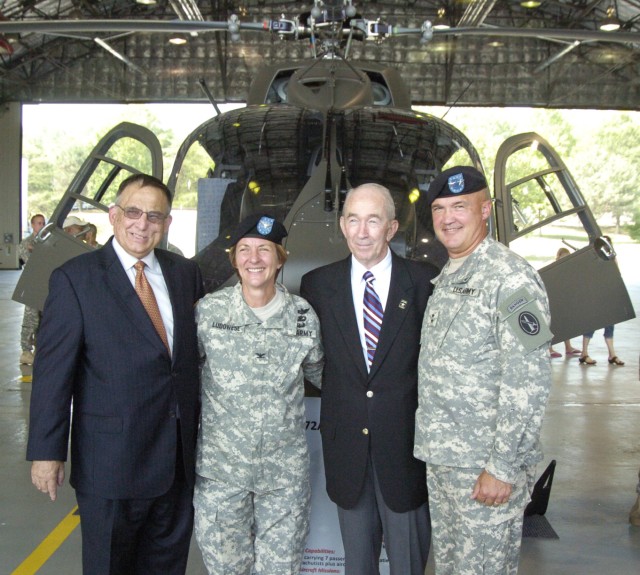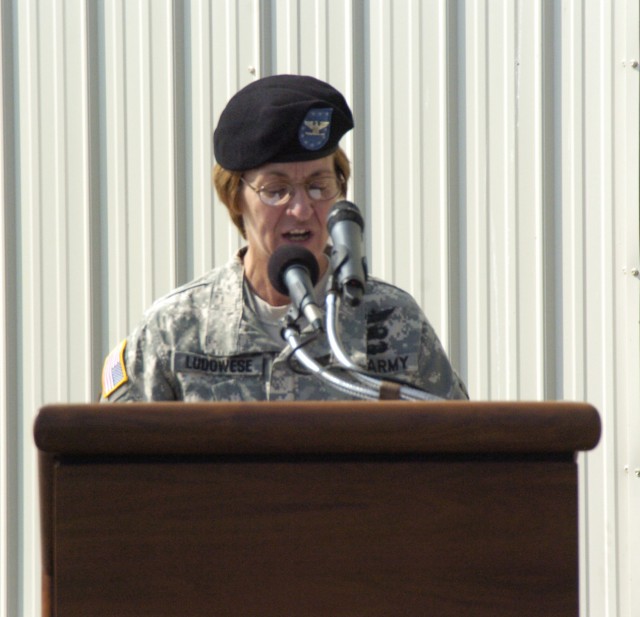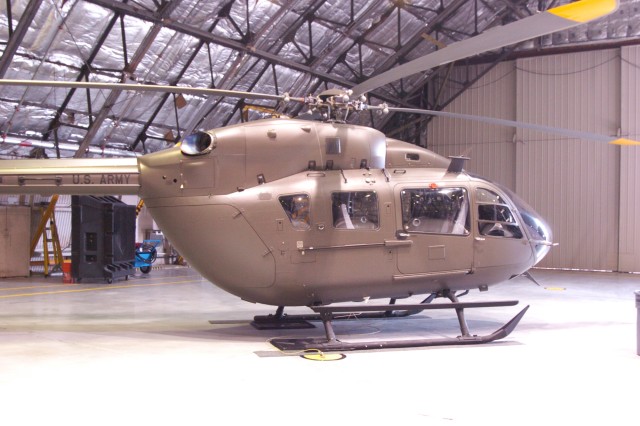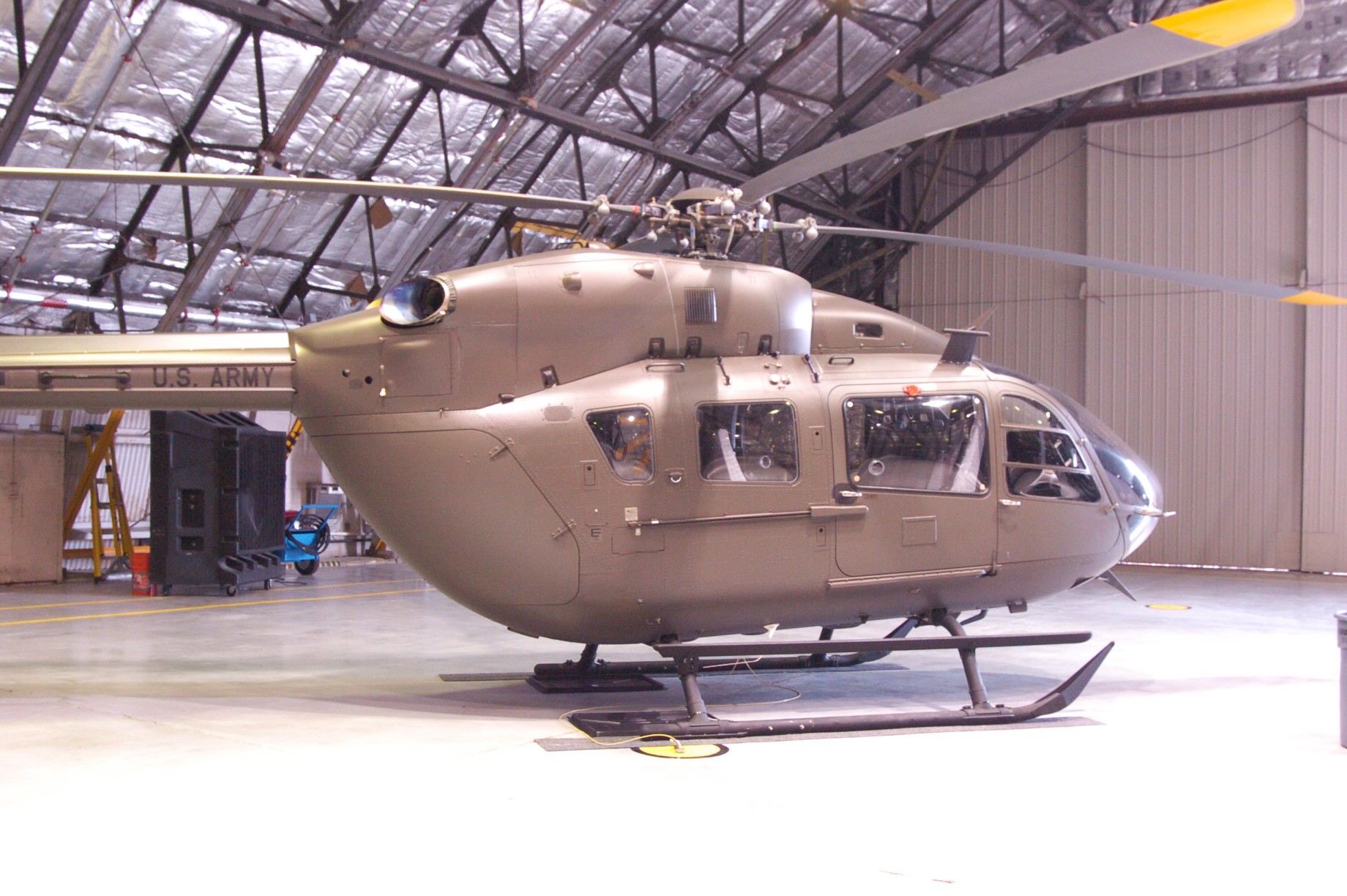The U.S. Army introduced a new state-of-the-art helicopter at Davison Army Airfield on Fort Belvoir Aug. 11 in conjunction with a ribbon-cutting ceremony for the hangar that will house the new aircraft.
The UH-72A is a commercially-developed twin engine helicopter that has the capability to perform homeland security missions, military medical evacuations, support damage assessments during natural disasters, provide search and rescue capability and augment counter-drug operations.
The UH-72As can be set up in any number of configurations. The two helicopters on display at Davison Wednesday had seating capacity for five in addition to two pilot positions. The version of the aircraft on view at Davison Wednesday was set up as a passenger transport vehicle within the National Capital Area. The helicopter will also be used as an essential enabler during the Homeland Security missions by providing defense support to civil authorities.
At the ceremony, Col. Jill Ludowese, commander of the Military District of WashingtonAca,!a,,cs Army Air Operations Group, spoke of the many partners who helped develop, field and bring the helicopter to fruition, including the funding of renovations to the hanger needed to maintain the Lakota.
Ludowese gave the roll-out context by providing a background history that led to the adoption of the helicopter.
Aca,!A"In 2002, 12th Aviation Battalion bid farewell to an old friend. Our UH-1 Hueys were phased out of the active Army, to be replaced by UH-60 Blackhawks. This force modernization effort left a hole in our organization that could not be readily filled,Aca,!A? she said. Aca,!A"Although the wings of freedom battalion required replacement aircraft to meet operations support airlift needs and NORTHCOM contingency plans in the National Capital Region, the Department of the Army was fighting two wars. Blackhawks were in short supply. The [DA] and the [MDW] looked at other options."
Ludowese said MDW recognized a good Aca,!A"fitAca,!A? with a commercial Aca,!A"light utility helicopterAca,!A? produced by European Aeronautic Defense and Space Company of North America, and that an operational needs statement to field eight Lakotas was approved by the Army vice chief of staff in 2007.
After the battalion commander spoke of improvements to the new hangar, an airborne Lakota made a pass over the tarmac behind a ceremonial tent, causing participants to stand, craning their necks to get a good view of whirlybird.
Invoking the search and rescue capabilities of the helicopter his company developed, retired Adm. David R. Oliver, the chief operating officer of EADS North America, spoke of the plane crash that took the life of former U.S. Senator Ted Stevens and injured former NASA director Sean OAca,!a,,cKeefe earlier this week in Alaska.
Aca,!A"I know what itAca,!a,,cs like to be the individuals who risk their lives to go into places [where people need help],Aca,!A? Oliver said, looking out at the Soldiers in the audience. Aca,!A?I truly believe this is a great helicopter Aca,!A| [that will allow you] to go out and do the extraordinary things you do.Aca,!A?
The ceremony ended with a ribbon-cutting to the strains the theme from Aca,!A"Rocky,Aca,!A? courtesy of the The U.S. Army BandAca,!a,,cs Brass Quintet. Attendees were next invited inside the hangar to see the new aircraft up close.
Aca,!A"ItAca,!a,,cs a beautiful airplane,Aca,!A? said CW3 Travis Stewart, a 12th Aviation Battalion pilot who fielded questions about the Lakota in the hanger. Aca,!A"The VIP setup is great for carrying [general officers].Aca,!A?
CW2 Steven Freund, another battalion pilot, said the instrument package was automated, convenient and well-designed. Aca,!A"I can tell it to go to a certain altitude and it will,Aca,!A? he said. Aca,!A"ItAca,!a,,cs a very stable aircraft.Aca,!A?
Aca,!A"This is not the first time IAca,!a,,cve seen a Lakota, this is the first time IAca,!a,,cve seen an MDW Lakota,Aca,!A? said Joint Force Headquarter-National Capital Region and Military District of Washington Commander Maj. Gen. Karl R. Horst during an interview at the ceremony. Aca,!A"IAca,!a,,cve seen other peoplesAca,!a,,c Lakotas and IAca,!a,,cve looked at them longingly, looking forward to today when we could introduce our Lakotas.Aca,!A?
Aca,!A"This has been a long-term proposition ... a good 18 months of hard work. I joined the MDW team while this was in progress, and what IAca,!a,,cve been able to do is help shepherd this project through the modernization program with the Department of the Army, with the Army Budget Office for the dollars we needed to renovate the hanger,Aca,!A? Horst said. Aca,!A"We [also] had to have a hanger facility that would sustain this aircraft. We couldnAca,!a,,ct put them in a substandard facility,Aca,!A? he said. Aca,!A"You had to have the infrastructure of the hanger before you could bring the aircraft here to sustain it. The big challenge was garnering the resources to repair, renovate and improve the hanger facility to sustain these aircraft.Aca,!A?
What it represents in terms of advanced avionics Aca,!" the glass cockpit, twin engines -- is a significant advantage,Aca,!A? Horst said of the helicopter. Aca,!A"The fact that it is a commercial off-the-shelf aircraft allows us to field them way ahead of the normal Army acquisition process, which puts them into the hands of the pilots, into our hangars way ahead of when we would have normally done it had we gone into the process of developing and acquiring a new aircraft. ItAca,!a,,cs a very good way to do business.Aca,!A?
Aca,!A"[The Lakota] is something that a commercial company could purchase for their private needs, yet it has enough applicability that we can transform it into something the military could use also. Commercial off-the-shelf technology with military applications is the wave of the future. I think EADS has developed a great product here and I think itAca,!a,,cs going to be very beneficial to our mission in the National Capital Region.Aca,!A?








Social Sharing